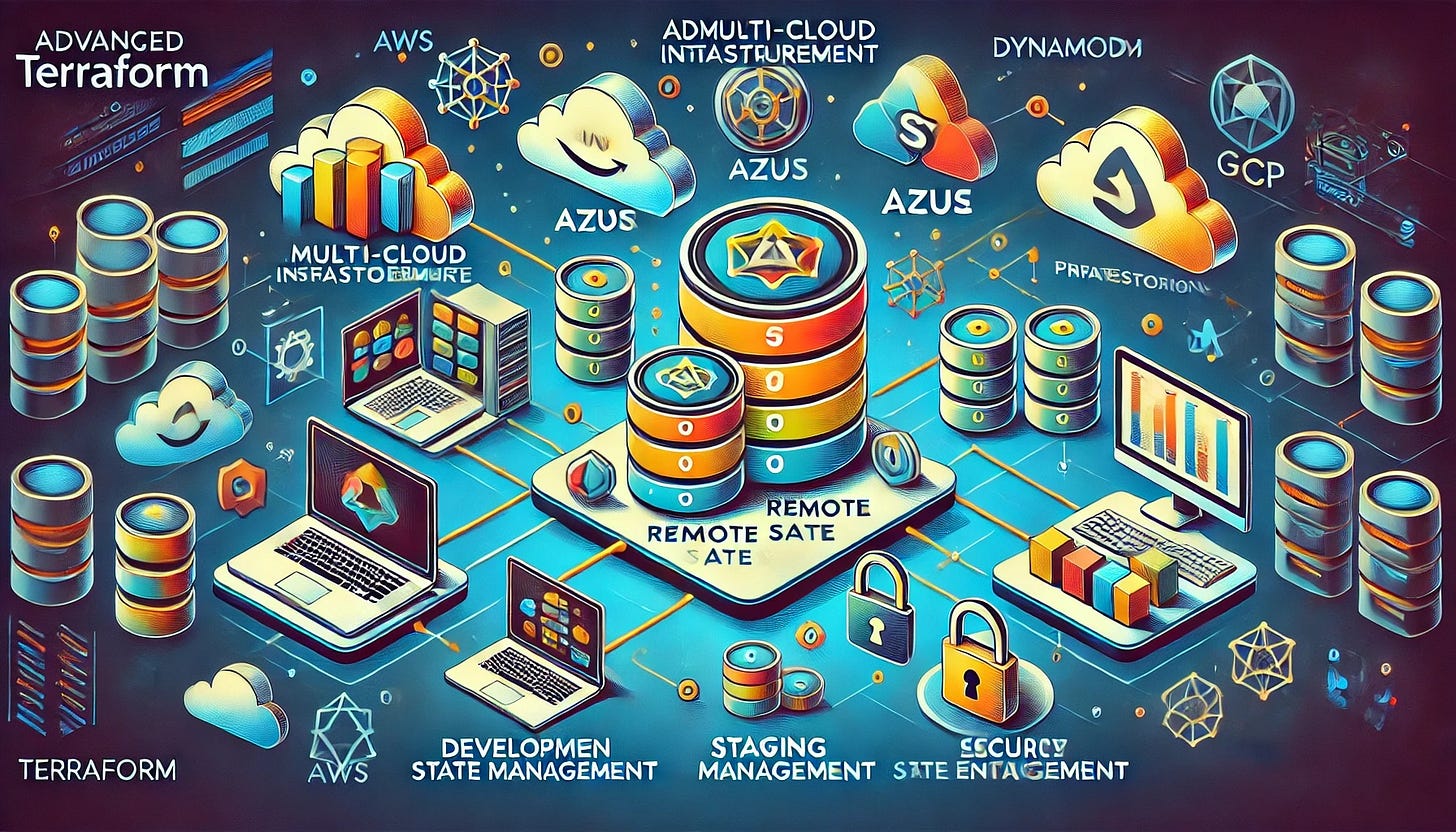Advanced Multi-Cloud Practices
Using Terraform Modules
Modules in Terraform are reusable building blocks that encapsulate specific functionality. By using modules, you can simplify your configurations, reduce duplication, and make your Terraform code more maintainable.
Creating a Module
Create a new directory for the module:
mkdir -p modules/aws_s3Inside the modules/aws_s3 directory, create the following files:
main.tf:
resource "aws_s3_bucket" "this" {
bucket = var.bucket_name
acl = "private"
tags = {
Name = var.bucket_name
Environment = var.environment
}
}variables.tf:
variable "bucket_name" {
description = "The name of the S3 bucket"
type = string
}
variable "environment" {
description = "The environment (e.g., dev, staging, prod)"
type = string
}outputs.tf:
output "bucket_name" {
value = aws_s3_bucket.this.bucket
}Using the Module in Your Configuration
In your main main.tf file, call the aws_s3 module:
module "aws_s3" {
source = "./modules/aws_s3"
bucket_name = "terraform-multicloud-example"
environment = "development"
}Run terraform plan and terraform apply to use the module. The module will create the S3 bucket as defined in its configuration.
Managing Multiple Environments with Workspaces
Workspaces in Terraform allow you to manage multiple environments (e.g., development, staging, production) within the same configuration. Each workspace has its own state file, enabling you to isolate resources for different environments.
Creating and Switching Workspaces
List available workspaces:
terraform workspace listCreate a new workspace:
terraform workspace new devSwitch to a specific workspace:
terraform workspace select devCreate additional workspaces for staging and production:
terraform workspace new staging
terraform workspace new prodUsing Workspaces in Resource Configurations
You can dynamically name resources based on the current workspace. For example:
resource "aws_s3_bucket" "example" {
bucket = "terraform-multicloud-${terraform.workspace}"
acl = "private"
tags = {
Environment = terraform.workspace
}
}This configuration will create different buckets for each workspace (e.g., terraform-multicloud-dev, terraform-multicloud-staging, etc.).
Remote State Management
In a multi-cloud environment, sharing the Terraform state file among team members is crucial. Remote state storage ensures that the state file is securely stored and accessible to everyone.
Setting Up a Remote Backend
For this example, use AWS S3 as the remote backend. Update your providers.tf file:
terraform {
backend "s3" {
bucket = "terraform-state-multicloud"
key = "terraform/terraform.tfstate"
region = "us-east-1"
encrypt = true
dynamodb_table = "terraform-lock"
}
}Explanation:
bucket: The S3 bucket where the state file will be stored.
key: The path to the state file within the bucket.
region: The AWS region where the bucket is located.
encrypt: Enables server-side encryption for the state file.
dynamodb_table: A DynamoDB table to manage state locking.
Initialize Terraform with the Remote Backend
After configuring the remote backend, reinitialize Terraform to migrate the state file to the remote backend:
terraform initTerraform will prompt you to confirm the migration of the state file. Type yes to proceed.
Testing and Validating Configuration
Validate Your Terraform Files
Use the terraform validate command to check your configuration for syntax errors:
terraform validateIf the validation is successful, Terraform will output a success message.
Lint Your Configuration
Use a Terraform linter like TFLint to ensure your configurations follow best practices:
Install TFLint:
# Linux
curl -s https://raw.githubusercontent.com/terraform-linters/tflint/master/install_linux.sh | bash
# MacOS
brew install tflint # macOS
# Windows
choco install tflintRun TFLint in your project directory:
tflintPlan and Apply Across Workspaces
Run terraform plan and terraform apply for different workspaces to test the separation of environments:
terraform workspace select dev
terraform plan
terraform apply
terraform workspace select prod
terraform plan
terraform applySecurity Best Practices
Protect Sensitive Data
Use environment variables or secret management tools to avoid hardcoding sensitive data like credentials. For example, you can use tools like AWS Secrets Manager, Azure Key Vault, or GCP Secret Manager.
Secure Remote State
Ensure your remote backend is configured with proper access controls. For example:
Use IAM roles and policies for AWS S3 and DynamoDB.
Encrypt the state file using server-side encryption (SSE).
Clean Up Resources
After testing, clean up all resources created in different workspaces:
Select each workspace and destroy its resources:
terraform workspace select dev
terraform destroy
terraform workspace select prod
terraform destroyRemove the workspaces if no longer needed:
terraform workspace delete dev
terraform workspace delete prodYou have gained a foundation in managing multi-cloud infrastructure using Terraform. You’ve also learned how to configure and authenticate Terraform providers for AWS, Azure, and GCP, deploy resources across these platforms, and optimize your configurations using outputs, modules, and workspaces. These skills not only enable you to orchestrate infrastructure efficiently but also prepare you for more advanced challenges in multi-cloud architecture, such as integrating CI/CD pipelines, managing state remotely, and implementing security best practices.
As organizations increasingly adopt multi-cloud strategies, your ability to handle cross-platform infrastructure with Terraform places you at the forefront of modern cloud engineering. To continue building on this knowledge, explore complex use cases like network peering across clouds, hybrid cloud setups, or compliance-focused configurations. With Terraform as your tool, the possibilities for creating scalable, reliable, and secure multi-cloud environments are virtually limitless.


